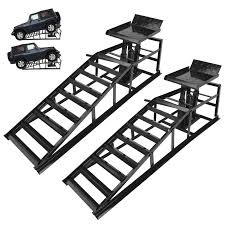
Car Ramps apsre essential tools for vehicle maintenance and repair, providing a safe and efficient way to elevate cars and trucks. This article explores the types of car ramps, their benefits, how to choose the right ramp, safety considerations, and additional aspects like usage tips, maintenance, and common alternatives.
What Are Car Ramps?
Car ramps are inclined platforms designed to lift vehicles off the ground, allowing easy access to the undercarriage. Typically made from materials such as steel, aluminum, or heavy-duty plastic, car ramps come in various sizes and weight capacities to accommodate different vehicles. They serve as an alternative to traditional jack stands, offering stability and ease of use.
Historical Context
The use of ramps can be traced back to early automotive maintenance. As vehicles became more complex, the need for effective tools to perform repairs increased. Car ramps evolved from simple wooden planks to sophisticated designs made from durable materials, catering to a growing DIY automotive community. Today, car ramps are widely recognized for their efficiency and safety in both professional and home garage settings.
Types of Car Ramps
Understanding the different types of car ramps can help you choose the right one for your needs. Here’s a detailed look at the various options available:
1. Portable Ramps
Description: Portable ramps are lightweight and easy to transport, making them ideal for DIY enthusiasts or mobile mechanics. These ramps are often made from durable plastic or aluminum, allowing for easy handling.
Benefits:
- Ease of Transport: Their lightweight design makes them convenient to carry and store.
- Versatility: Suitable for various vehicles, from compact cars to larger SUVs.
Considerations:
- Weight limits may be lower than heavy-duty ramps, so always check specifications.
2. Heavy-Duty Ramps
Description: Heavy-duty ramps are built to support larger vehicles or more extensive repairs. Constructed from steel, they provide increased stability and weight capacity.
Benefits:
- High Weight Capacity: Designed to support trucks and larger SUVs.
- Durability: Resistant to wear and tear over time.
Considerations:
- Heavier and less portable than other options.
3. Foldable Ramps
Description: These ramps offer convenience and easy storage, as they can be collapsed when not in use.
Benefits:
- Space-Saving Design: Ideal for those with limited garage space.
- Easy Setup: Simple to unfold and use.
Considerations:
- Ensure that the folding mechanism is robust for safety.
4. Race Ramps
Description: Specifically designed for sports cars and racing vehicles, race ramps feature a lower incline to prevent undercarriage scraping.
Benefits:
- Optimal Design for Low Clearance: Allows low-profile vehicles to drive onto the ramp without damage.
- Stability: Offers a wide base for better weight distribution.
Considerations:
- May not be suitable for standard vehicles due to their specific design.
5. Low-Profile Ramps
Description: Low-profile ramps cater specifically to vehicles with lower ground clearance, ensuring a smooth transition onto the ramp.
Benefits:
- Accessibility: Perfect for sports cars and modified vehicles.
- Safety: Reduces the risk of damage when driving onto the ramp.
Considerations:
- Limited weight capacity compared to standard ramps.
Benefits of Using Car Ramps
1. Improved Access
Car ramps provide better access to the undercarriage of your vehicle, allowing for maintenance tasks such as oil changes, tire rotations, and brake repairs. This enhanced access is especially beneficial for those who prefer to perform their own vehicle maintenance.
2. Stability
When used correctly, car ramps offer a stable platform that can support the weight of the vehicle. This stability reduces the risk of accidents compared to using jacks alone, which can sometimes shift or fail if not positioned correctly.
3. Ease of Use
Ramps are generally easier to set up and use than traditional jacks. Simply drive the vehicle onto the ramp, and you’re ready to work underneath. This ease of use makes them accessible for individuals of varying skill levels, from beginners to seasoned mechanics.
4. Cost-Effective
Investing in a set of car ramps can save money on professional repairs and maintenance. Many vehicle owners find they can handle simple tasks on their own, reducing the need for costly trips to the mechanic.
5. Enhanced Safety Features
Many modern car ramps come equipped with safety features, such as non-slip surfaces and safety straps, ensuring that the vehicle remains securely in place while you work.
Choosing the Right Car Ramp
When selecting a car ramp, consider the following factors to ensure you make the best choice for your needs:
1. Weight Capacity
Check the ramp’s weight limit and ensure it can safely support your vehicle’s weight. Always choose ramps with a higher capacity than your vehicle’s weight for added safety. For instance, if your car weighs 3,000 pounds, opt for ramps that can support at least 4,000 pounds.
2. Ramp Length and Height
Consider the angle of the ramp; a longer ramp will create a gentler incline, making it easier for lower vehicles to drive onto. Additionally, ensure that the height of the ramp allows you to access the undercarriage for the specific maintenance tasks you plan to perform.
3. Material
Choose ramps made from durable materials. Steel ramps are typically more robust but heavier, while aluminum ramps are lightweight and easier to transport. Plastic ramps can be effective for lighter vehicles but may not offer the same stability or durability.
4. Portability
If you need to move the ramps frequently, consider their weight and whether they can be folded for storage. A lighter ramp can be easier to maneuver, especially for those who may not have a dedicated workspace.
5. Surface Type
Look for ramps with a non-slip surface to enhance safety. Textured surfaces can help prevent the vehicle from sliding off while driving onto or off the ramp, which is crucial when working on inclined surfaces.
Safety Considerations
Safety should always be a priority when using car ramps. Here are some essential tips to keep in mind:
1. Inspect the Ramps
Before use, check for any signs of wear, damage, or instability. Ensure that the ramps are placed on a flat, stable surface. Inspect the ramps regularly for cracks or deformities, particularly if they are frequently used.
2. Proper Positioning
Align the ramps correctly with the vehicle’s wheels. Ensure they are level and secure before driving onto them. Misalignment can lead to dangerous situations, including slipping or tipping.
3. Use Wheel Chocks
Always place wheel chocks behind the rear wheels of the vehicle to prevent it from rolling backward while elevated. This is a crucial step, especially if you are working on a slope.
4. Avoid Overloading
Never exceed the weight limit specified by the manufacturer. If you are unsure, err on the side of caution and choose ramps with a higher capacity. Overloading ramps can lead to catastrophic failures.
5. Work Carefully
Always exercise caution when working under a vehicle. Ensure that you have all the necessary tools and equipment on hand to avoid unnecessary movements under the vehicle. Avoid placing any part of your body near the wheels while they are elevated.
Tips for Using Car Ramps
To maximize the effectiveness and safety of car ramps, consider these tips:
1. Practice Driving On and Off
Before working under the vehicle, practice driving onto and off the ramps in a controlled environment. Familiarizing yourself with the process can help you gauge how your vehicle interacts with the ramps.
2. Check the Ground Surface
Ensure that the ground where the ramps will be placed is flat and stable. Uneven surfaces can compromise the stability of the ramps and pose a safety risk.
3. Positioning the Ramps
When positioning the ramps, make sure they are aligned with the wheels and level. This reduces the risk of slippage and helps maintain vehicle stability.
4. Maintain Your Ramps
Regular maintenance of your ramps can extend their lifespan. Clean them after use to remove debris, and store them in a dry place to prevent rust or deterioration.
5. Follow Manufacturer Instructions
Always adhere to the manufacturer’s guidelines for use, weight limits, and safety precautions. Each ramp may have specific instructions that ensure safe and effective use.
Alternatives to Car Ramps
While car ramps are a popular choice for vehicle maintenance, there are several alternatives to consider:
1. Jack Stands
Jack stands are a more traditional method for elevating vehicles. They are typically used in conjunction with a hydraulic jack to lift the car before securing it on the stands. This method provides stability but requires careful placement and additional steps.
2. Hydraulic Jacks
Hydraulic jacks can quickly lift a vehicle, but they must be used with jack stands for safety. They offer high weight capacities and can be used for a variety of maintenance tasks.
3. Creepers
If you prefer not to elevate the vehicle, a mechanic’s creeper can be used to slide under the car while it remains on the ground. This option is less about elevation and more about ease of access.
4. Vehicle Lifts
Professional garages often use hydraulic lifts for significant repairs and maintenance. These lifts can elevate vehicles entirely off the ground but are generally more expensive and require more space.
5. Wheel Ramps
Similar to car ramps, wheel ramps allow you to elevate just the wheels of the vehicle, making it easier to access certain areas without raising the entire vehicle.
Common Uses for Car Ramps
Car ramps can be utilized for various maintenance tasks, including:
1. Oil Changes
Elevating the vehicle provides easy access to the oil pan and filter, making oil changes simpler and more efficient.
2. Brake Repairs
Accessing the undercarriage is essential for brake repairs. Ramps allow you to inspect brake lines, pads, and rotors effectively.
3. Exhaust Work
Ramps provide ample space for exhaust system repairs and modifications, making them invaluable for DIY enthusiasts and mechanics.
4. Tire Changes
Changing tires can be made easier with ramps, allowing for better access to the wheel wells and suspension components.
5. Inspection and Cleaning
Ramps allow for thorough inspections of the undercarriage, enabling vehicle owners to clean and inspect for rust, leaks, or damage.
Conclusion
Car ramps are invaluable tools for anyone looking to perform vehicle maintenance and repairs. By understanding the different types, benefits, safety considerations, and usage tips, you can choose the right ramps for your needs. Whether you’re a seasoned mechanic or a DIY enthusiast, investing in a good set of car ramps can enhance your vehicle maintenance experience and keep your car in top shape. Proper use and regular maintenance of your ramps will ensure their longevity, safety, and effectiveness in all your automotive tasks For more detail please visit techwebinsights.com





